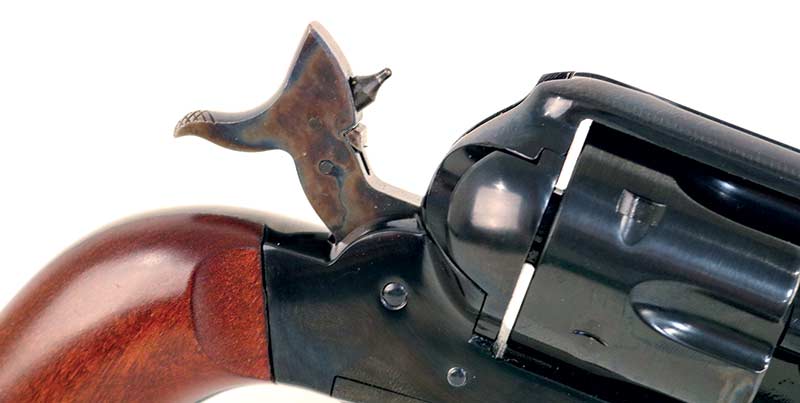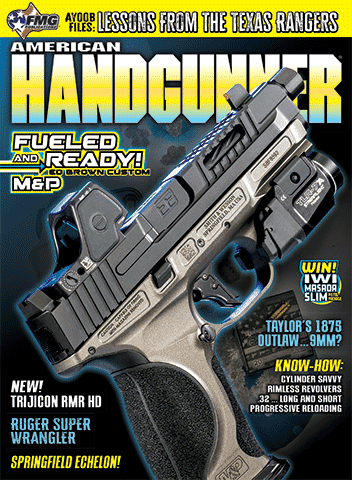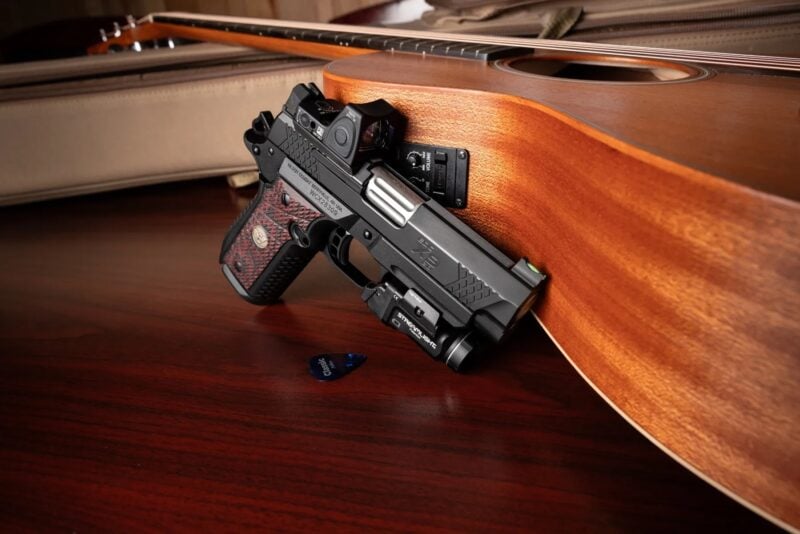Wild, Wild West in 9mm?
The Taylor’s 1875 Outlaw Revolver
Taylor’s & Company has built a well-deserved reputation for offering top-quality Western-themed firearms at reasonable prices. Their guns are the spitting image of their vintage counterparts while being built using modern materials and production techniques. With the explosion of interest in the SASS (Single Action Shooting Society), cowboy action shooting, and Old West reenacting, the market for vintage firearms has never been stronger. Taylor’s newest offering is the 1875 Outlaw in 9mm Parabellum.
The 1875 Outlaw is a faithful rendition of the 1875 Remington single-action revolver. While the Colt Single Action Army got all the press, the top strap Remingtons were strong, accurate and reliable. In his prime, legendary outlaw Frank James rocked an 1875 Remington with a 7½” tube.
James used Remington revolvers during his service in the Civil War and held them in high esteem. In his words, “The Remington is the hardest and the surest shooting pistol made.” Considering the source, that’s pretty high praise.
As one might expect, Taylor’s 1875 features a beautiful forged blued steel frame and barrel, a two-piece walnut grip and the gun’s characteristic webbed ejector rod tube. However, that’s where the old stuff ends. This 1875 is chambered for the more modern 9mm
Parabellum cartridge.
Georg Luger designed the 9mm Para in 1901. Despite its being well over 100 years old, this compact yet powerful round is the most-produced centerfire pistol cartridge on the planet today. When charged with modern high-performance loads, the 9mm 1875 Outlaw is soft-shooting while projecting plenty of downrange thump. The synergistic combination of the Taylor’s 1875 Outlaw and the 9mm Parabellum is the perfect solution to some unique defensive challenges.
Wild, Wild West
Artemus Gordon took an Uber to the front gate of the unmarked government facility in rural Virginia. He thanked his driver, a Pakistani national named Tanvir, who was working to bring his family over from Faisalabad, and exited the vehicle with his day bag. Tanvir asked what he was doing out so far in the country, and Gordon simply answered work. That was not altogether untrue.
Gordon flashed his credentials to the security officer in the simple metal building unnecessarily. He and Eddie had known each other for several years now. Ever since meeting the TDA recruiter at the Delta compound at Fort Bragg, Captain Artemus Gordon, formerly of the U.S. Army Special Forces, had spent most of his time working at this top-secret facility. TDA stood for Time Displacement Administration.
Gordon found his deployment clothes waiting in the locker room as expected. He changed out of his 5.11s and Under Armour in favor of long john underwear, rough homespun, and a pair of well-aged boots. He checked his pockets one last time to ensure he had sanitized himself of everything made in the 21st century, powered off his smartphone, and secured it all in his locker. His deployment briefing was scheduled in 10 minutes.
Miguelito Quixote Loveless would actually be born in St. Petersburg, Russia, in another seven years. He was the reason Artemus Gordon was about to step into the time displacement apparatus and reappear in 1877 to meet his counterpart James West. West was already deployed and waiting, though “waiting” was a relative term when time machines were involved.
Dr. Loveless was a malignant dwarf with a genius IQ and a propensity for megalomania. He had developed and exploited theoretical time displacement along a parallel arc from the U.S. government and sent himself back to the late 1800s to sow chaos. Like so many psychopaths, Loveless wanted to rule the world. However, he was insightful enough to realize this was an unreasonable aspiration in the interconnected digital age. To wield truly supreme power, he would have to start somewhat earlier. Gordon and West were tasked to stop him by any means necessary before he disrupted all subsequent time streams.
The briefing was a formality. Like an astronaut, Gordon had trained for this particular mission for months. He drew his weapons and equipment from the TDA quartermaster and packed it all to his liking inside a brace of shopworn leather saddlebags. He carried a change of clothes, a straight razor and toiletries, and $1,000 in vintage gold pieces. His weapon was a modern 9mm rendition of the tried-and-true Remington 1875 revolver.
The gun had been a special order with markings that reflected the period. The cartridge was chosen for its proven controllability, accuracy and downrange effectiveness. He dropped five Winchester PDX-1 Defender hollowpoints into the cylinder and slid the gun into his well-used low-ride leather thigh rig. It rode there like a piece of his anatomy. Gordon dropped another 200 loose rounds into a cloth sack and stowed them in his bag.
Once he was satisfied everything was as it should be, Gordon stepped onto the glowing platform and smiled at the technician. Her name was Monica. She was a gorgeous strawberry blonde whose number he had secured in his phone. With a nod, she energized the coils, browned out half of the Eastern seaboard, and sent CPT Artemus Gordon back to meet his friend in 1877. If all went as planned, Gordon and West would be back in two weeks with Dr. Loveless neutralized. If they failed, then everything and everyone he had ever known, including Monica, would likely just cease to exist. No pressure …
Details
The Wild, Wild West ran for four seasons from 1965 through 1969. Coming just as the golden age of Hollywood Westerns began to wane, this inspired piece of high-end television bridged the gap between traditional Westerns and the burgeoning spy genre. Its creator, Michael Garrison, first pitched the show as “James Bond on horseback.” The end result was vintage TV gold.
The Wild, Wild West was part comedy, part action/adventure and part unfiltered fantasy. In crossing such disparate genres, this groundbreaking production helped usher in the steampunk era. The original show did not, to my recollection, involve time travel. However, if Jim West and Artemus Gordon did need to arm themselves in the Information Age to remain secure in the late 19th century, the Taylor’s 1875 Outlaw 9mm seemed the right sort of iron.
The Gun
The original was technically the Remington Model 1875 Single Action Army or the Frontier Army. It was designed in direct response to Colonel Sam Colt’s 1873 Peacemaker. Developed from the previous Remington Model 1858 cap and ball revolver, the Frontier Army kept the same rugged top strap design and webbed frame while incorporating a removable bored-through cylinder chambered for modern metallic cartridges. The original 1875 Remington was produced in .44 Remington Centerfire, .44-40 and .45 Caliber. Standard physical attributes included a fluted cylinder, walnut stocks, a blued or nickel-plated finish and a lanyard ring. Barrels were offered in 7½” and 5¾” versions, though the longer tube was much more common.
The Taylor’s 1875 Outlaw loads from the right side via a loading gate in the manner of a Peacemaker. The rimless 9mm Para cartridge headspaces on the case mouth. This makes the round fairly impractical in guns that utilize a star ejector. However, with a manual rammer-style ejector like that of the 1875 Remington, the gun ejects empties in much the same way as it might in vintage rimmed chamberings.
The gun weighs 2.7 lbs. and is just over a foot long. The ample firing pin is built into the hammer just like the originals. Packing the gun with the hammer down over an empty chamber just channels some of that Frank James ambiance.
The rear sight is a fixed notch ground into the frame. The barrel is rifled 1:16″ with a right-hand twist. The diaphanous single-action trigger breaks like a little girl’s heart and the deep-blued finish is simply gorgeous.
Ruminations
The biggest difference between the Taylor’s 1875 Outlaw 9mm and more conventionally chambered wheelguns is that ammo is soft-shooting and cheap. FMJ 9mm blasting bullets cost a fraction of what .45 LC might. Additionally, as this is a single-action revolver, the gun really doesn’t much care what you feed it. Lightweight polymer bullets, big 147-grain subsonics, or heavy, hot 124-grain SMG rounds, the 1875 Outlaw eats them all with aplomb. The combination of the sweet, crisp trigger and the gun’s ample steel habitus makes it a sweetheart on the range. Legit, I can see why Artemus Gordon would choose it. The 1875 Outlaw is an absolute joy to shoot.
When my kids would bring friends home from college to burn bullets, the machineguns always grabbed everybody’s attention. However, at the end of the day, it was invariably the vintage wheelguns that kept everyone most enthralled. I honestly have lost count of how many times half a dozen rangy college guys had, like locusts, burned up all of my cowboy action bullets in an afternoon. Now thanks to Taylor’s, you can get that same vintage single-action sweetness without breaking the bank. It’s your key to tasting the wild, wild west.
For more info: TaylorsFirearms.com













